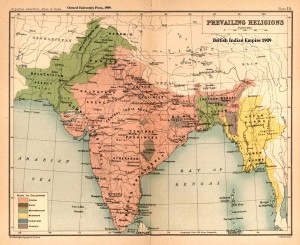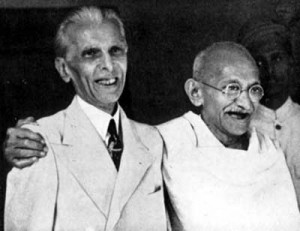This day in 1947, India became an independent state from Great Britain, and August 14th, 1947, Pakistan had also become independent. How is this information useful? Understanding these two countries helps us understand the region, and current events. Let’s learn more…
End of the empire

Prior to independence, the Indian subcontinent had been under British control for more than two centuries (first governed by the British East India Company, then by the British government directly. The British Parliament passed an independence act for the Indian colony in July, 1947.
India, Britain’s largest colony, had a mixture of ethnic and religious populations, and the creation of Pakistan followed a generally religious division. The Hindu population formed the modern nation of India, while the predominantly Muslim north-west portion of the colony became Pakistan.
…And more conflict
These events were the culmination of centuries of armed revolts, peaceful protests, and the eventual lessening of British resolve to retain colonies.

And, after becoming independent, India and Pakistan promptly went to war with each other about border disputes.
These territorial conflicts were revisited several times over the decades, and resulted in the formation of Bangladesh, and provided the stimulus for both India and Pakistan to develop nuclear weapons.
There is still very real tension between the two states, but it is also quite theatrical. Take a moment to watch Exhibit A, the India/Pakistan border closing ceremony:
–
I say again, these countries both have nuclear weapons.
The Commonwealth
Both India and Pakistan are members of The Commonwealth, too. The British Commonwealth, now referred to simply as “The Commonwealth” began as an idea in the 1840s, and became a formal, modern organization in 1949. It is self-described as a “voluntary association of 53 independent countries.” Those countries, except a few recent additions, were all formerly part of the British empire. Therefore they generally share the English language and have at least the seed of democratic ideals (although the practice of each is still a work in progress).
The Commonwealth website describes its charter this way:
“The Charter brings together the values and aspirations which unite the Commonwealth – democracy, human rights and the rule of law – in a single, accessible document.
The Charter expresses the commitment of member states to the development of free and democratic societies and the promotion of peace and prosperity to improve the lives of all peoples of the Commonwealth.
The Charter also acknowledges the role of civil society in supporting the goals and values of the Commonwealth.”
Tension today
Of course, the Commonwealth’s charter doesn’t stop member states from having coups and succumbing to military rule (as was the case for Pakistan under Musharraf, etc.), but it is a nice ideal. Speaking of military rule, there is fear today in Pakistan that tensions between several populist groups and the government will give way to some kind of martial law. Yesterday’s independence day celebrations were sedated because of this tension. See this news for more information:
http://www.cnn.com/2014/08/14/world/asia/pakistan-anti-government-march/
Was this post interesting? Did you learn anything? Please take a moment to share it with your friends via email, or on Facebook!
More information:
Here is another angle on how the Indians and Pakistanis view their history:
Find more about the Commonwealth at their website:
The CIA Factbook always has lots of cool data:
https://www.cia.gov/library/publications/the-world-factbook/geos/in.html
https://www.cia.gov/library/publications/the-world-factbook/geos/pk.html
And official governmental sites are good sources of local bias:
Just visited your blog for the first time. Beautifully done! From an old (1981) Asbury history major to a young one, keep up the great work. Mark